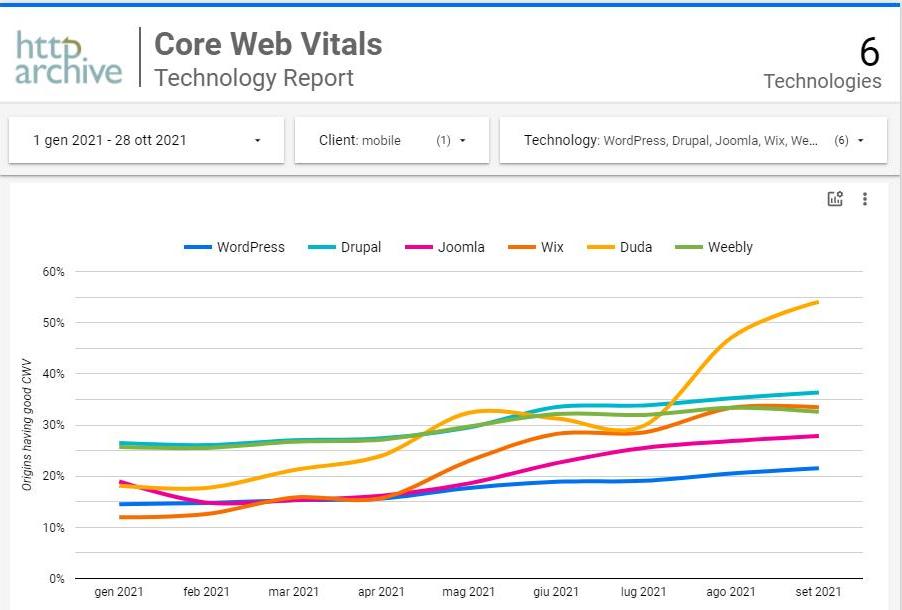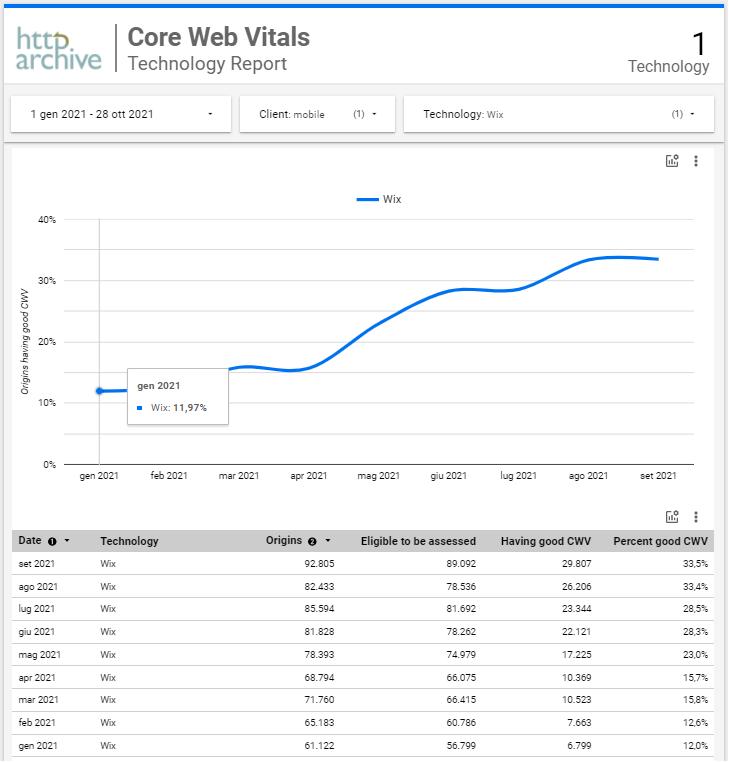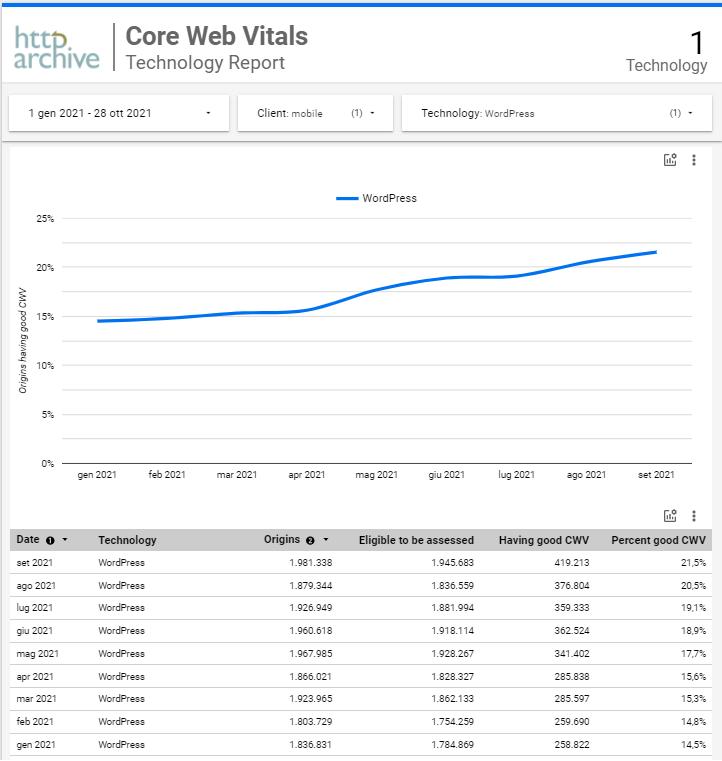Which CMS wins the performance challenge for Core Web Vitals?
For some months now we have been dealing with the effects of the Page Experience Update, which started in June 2021 and officially introduced (also) the Core Web Vitals among the ranking factors taken into account by Google’s algorithms, and it may be useful to take stock of the situation on some of the aspects that may influence the technical performance of our sites. CMSs are one of the critical elements, and a study reveals how they are actually behaving and what advantages (or disadvantages) they give to those who use them.
The HTTP Archive study on CMS and Core Web Vitals
HTTP Archive, which has published a new version of the real statistics on the performance of Core Web Vitals of the main CMS platforms, monitors the responses of the Content Management System, following the work already inaugurated last March and highlighting the progress made and those still needed to ensure optimal service.
In summary, as noted by Roger Montti, it is noted that many commercial and even open source platforms have achieved improvements in the performance of Core Web Vitals, but above all that the most significant gains in terms of performance were the result of proactive initiatives put in place in the past months.
CMS and Core Web Vitals, real performances according to HTTP Archive
The new data set available allows you to personally verify the performance of CMS with reference to the parameters of the three Core Web Vitals; following the work of Montti, we compared the performance of some of the main CMS, that highlight how WordPress appears to be late compared to competitors.
Indeed, it is clear that the world’s most popular CMS has a much lower percentage of sites that meet the CWVs thresholds than alternative platforms such as Wix, Weebly, Duda, Drupal and Joomla, both desktop and mobile.
To be precise (and net of the inevitable quantitative differences of the sample examined, which for WordPress examines a number of origins higher than up to ten times that of competitors), data updated to October 2021 show that well over 50 percent of websites created with Duda has a good Core Web Vitals score from both desktop and mobile browsing, with a high increase compared to performance at the start of 2021, which were less than 20 percent.
And if, roughly, all the other CMSs have taken decisive steps forward – the graphs show the growth of Drupal, Wix, Weebly and Joomla, which currently exceed the CWV thresholds in about 30 percent of cases from mobile and up to 40 percent from desktop – It is obvious how WordPress, instead, proceeds slowly.
At the beginning of the year, in fact, only 15 percent of the origins examined by HTTP Archive had good Core Web Vitals values, and after ten months the share has risen to just 26 percent, an increase that can be defined at least modest (in general and in reference to the leaps forward of the other platforms).
The reason for the success of other CMSs in technical performance
Montti has tried to analyze the reasons behind these numbers, revealing in particular that commercial platforms like Duda and Wix that make significant improvements to their technologies to meet the needs of site owners, with results that clearly demonstrate the success of this strategy.
Duda is a website creation platform for Web professionals that has some traits in common with WordPress and allows a significant space for the code modification. However, compared to the more well-known and widespread competitor, Duda retains control over the underlying technology to ensure high performance, allowing the CMS development team to work on the functionality users want, like the high speed page performance.
Wix is another closed system that allows companies to create a presence on the Web and start doing business online quickly: all updates and technological improvements are managed by Wix, that takes charge of it to allow its customers to focus on their business. Like Duda, this year Wix has dedicated resources to improving search engine optimization and Core Web Vitals scores for its customers.
But it’s not just private platforms that improve in response to CWV, because even Drupal, which is open source, has seen its performance rise, and therefore penalizing WordPress is not necessarily the fact of being open source and managed by a committee.
Duda’s winning strategy to improve Core Web Vitals
The editor of Search Engine Journal interviewed representatives of Duda and Wix to find out what concrete interventions were implemented this year that might have given the boost to the performance of the platforms.
And so, Duda revealed that he bet heavily on the satisfaction of the Core Web Vitals that “is a very important topic for our customers”, deciding to launch “a task force with the aim of being the number 1 CMS with CWV scores”. In detail, the platform has adopted a very data-driven approach, installing the Google CWV library on all its sites and sending the collected data to the business intelligence tool (BI) used to view the data.
In this way, Duda had information about the performance of CWVs over time, which could filter according to different parameters such as the template type, the account (thanks to the collaboration with “large partners with many thousands of sites on the platform”), geolocation, the features of the site that were used and more, thus coming to identify opportunities for improvement, which were implemented and then further verified on the field.
In addition, the brand has faced another issue, namely the difficulty of intervening with repairs on a website creation platform that allows developers to add their own scripts and widgets, deciding in this case for a shared approach with the users themselves.
This was done specifically to solve problems with cumulative layout shift (CLS), namely page jumps during loading that create a poor user experience, which is found to click on an interactive object that moves and makes it frustrated. This is a top priority for all websites, the incidence of which has worsened since the use of third-party apps: Duda has therefore worked with those app developers to optimize apps and to solve some common problems.
For example, having noted that CLS is often caused by delayed loading of Google Fonts, Duda has entered the fonts needed to view content above the fold; added relational attributes to any image because images without adequate width/height attributes cause annoying variations; they have improved with partners some custom widgets uploaded to Javascript that caused CLS.
The results show that this model of iterative intervention has helped the platform to improve scores over time, thanks to a proactive approach that has allowed to identify weak areas and thus collaborate with customers to solve the issues.
Wix’s strategy
Wix is another platform awarded by the latest performance statistics from the HTTP Archive Core Web Vitals Technology Report, and Dan Shappir, Wix’s Performance Tech Lead, explained how these scores could be achieved: “We have adopted a performance-oriented corporate culture“, he explained, “putting performance at the center of every feature, component and element we provide and build”.
In this way, Wix managed to “get significant improvements for Vitals Web Cores and we increased by 750% the ratio between Wix sites with good scores for all three CWVs in the Google Crux report”. But performance is “a path, not a goal, and we will continue to use this momentum to improve the performance of our users and visitors to their site,” concluded Shappir.
Only a few years ago developers and publishers who worked with WordPress liquidated platforms like Wix calling them “late in terms of SEO and performance metrics”and indeed at that time such closed commercial platforms might seem to be focused primarily on the visual aspect of the site and not sufficiently on features related to SEO and page speed, for example. From 2020, however, commercial build-it-yourself platforms also turned their eyes to improving the SEO and page speed performance, and the data from the HTTP Archive study tell us how effectively they have improved in ensuring outstanding technical performance.
The reasons for the delay of WordPress on Core Web Vitals
We can not, at this point, do not ask why WordPress is late, as also admitted by the same developers of the CMS, who launched the proposal to set up a “Wordpress performance team” to coordinate work efforts to improve page speed and increase performance.
In the same proposal it manifests awareness that WordPress is “lagging behind other platforms (e.g. Wix, Shopify, Squarespace)”, which “are on average faster – and are becoming faster – than WordPress sites”.
The absence of a centralized structure to coordinate work and efforts can be one of the reasons for delays in WordPress compared to other platforms, and therefore the establishment of this team could be a significant step forward in improving performance progress.
Thierry Muller, Software Engineering Manager at Google (and WordPress core contributor), revealed that his Google team has “conducted analysis on the 100 most popular themes and on various real WordPress sites (from small to large) to better understand which area is damaging the majority of WordPress sites”.
The results of this analysis show that the biggest problems are modern image formats, responsive images followed by Javascript run time, unused Javascript, rendering block resources, redirects, long TTL cache, and this can be the starting point for a roadmap of areas on which WordPress must focus to improve performance.
Thierry himself adds that the project should not end with the correction of the WordPress core, but could also extend to the addition of performance signals to the checklist review of themes and plug-insin, and then the effort to improve the performance of WordPress could theoretically extend to developers of plugins and themes.
The problem with this situation, Montti rightly points out, is that the Core Web Vitals were introduced much more than a year ago and at a distance of all this time “Wordpress is only now discussing the creation of a group to address the nodes of performance and is still far a deal to actually do anything”.
The importance of the study to SEOs
The report of HTTP Archive Core Web Vitals Technology highlights that commercial platforms such as Duda and Wix are making giant strides to respond to the new technical challenges affecting the sites and, consequently, also the SEO, while the data are worrying for WordPress.
The study is important because it provides an overview of the performance of Core Web Vitals and the direction in which a given platform is going, which can help to improve (or worsen) the actual performance of our pages.
Solving Core Web Vitals is important in terms of ranking, but not only (and not so much) because they are a positioning factor for Google with the Page Experience, but because they work to fix issues with themes, plugin and the same CMS to improve the metrics Core Web Vitals is “a distraction from the business activity and promotion of the site itself”, ie are “energy, time and money that otherwise could be spent on content and promotion”, summarizes the expert.
And of course, the performance of our pages depends mainly on our choices in terms of themes, plugins, widgets and so on, but the report indicates that even the CMS itself can have an impact.
The methodology of the report
As latest methodological notations, we stress that the comparison covers scores from the beginning of 2021 related to sites located in the United States, for navigation from mobile and desktop; However, the tool developed by HTTP Archive allows you to select many website builders and content management systems and compare their performance.
Some site creation platforms have been omitted from the analysis because, explains Montti, they are too far behind, they have been evaluated only for a few months or because they do not offer a sufficient sample of sites built with the technology considered.






